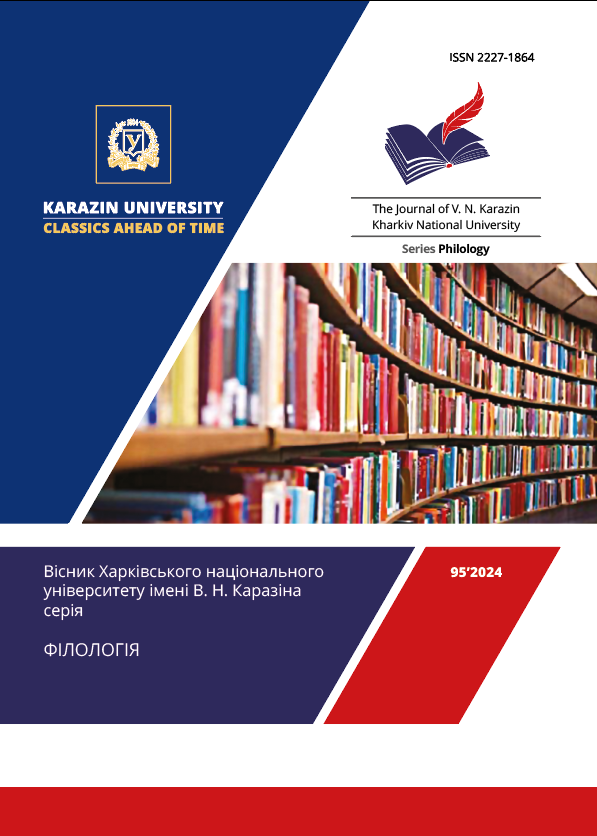Imagist Novel’s Poetics: “Bid Me to Live” by H.D.
Abstract
During its formative years, Imagism hasn’t left any profound theory as far as the criteria for producing new prose. Since then the problem has been under-studied and calls for more in-depth analysis. The paper aims at examining the paradigmatic features of the Imagist lyric narrative of “poetic novel” (S. Spender) taking H.D.’s “Bid Me to Live. Madrigal”as a model. It is emphasized that it is roman à clеf where behind all significant characters are historical prototypes, the main ones of which are Julia Ashton (Hilda Doolittle), Rafe (Richard Aldington) and Rico (D.H. Lawrence). Open form and fragmentation, intertextuality and collaging, “stream of conscience” elements and time shifts et al –– a lot of modernist novel’s features can be found in H.D.’s novel. But unique Imagist poetic techniques for prose are being pointed out in front of the in-famous Modernist prose texts –– V. Woolf’s “Mrs Dalloway” and R. Aldington’s “Death of a Hero”. Narrative’s “vertical structure” (S. Friedman), typical for a lyric novel, focuses on the narrative-transformation of heroine at the moment of her deepest personal crisis both in the life of a woman and an artist against the catastrophic background of the First World War. The novel’s poetics analysis proves that author's narrative strategy lies in searching and finding imagistic correlates of individual images, descriptions and whole scenes-situations. Often, the search process is specifically coming out in order to attract the reader’s attention to it, and the most important images-patterns-situations are repeatedly reiterated. This is the basis of H.D.’s lyric narrative, a kind of Imagist self-madrigal. The poetics of the Imagism prose, adopted from the Imagism poetry, is a search and finding of patterns in their juxtaposition, that interact as coordinating. Throughout the novel, these "patterns" are being transformed into images, reliably providing pictures, emotions, or ideas. The difficult world of Julia opens up exactly via such "patterns", strategically underlined with proleptic and analeptic violations of linear time.
Downloads
References
Ortega-i-Gasset, H. (1994). Doomky pro roman// Ortega-i-Gasset, H. Vybrani tvory. Per. z isp. V. Sahna. K.: Osnovy. P. 273-305.
Freedman R. (1963). The Lyrical Novel: Studies in Herman Hesse, Andre Gide, and Virginia Woolf. Princeton University Press. 310 p.
H.D. (1983). Bid Me to Live. A Madrigal. Black Swan Books Ltd. 211 p.
H.D. (1983). Collected Poems 1912-1944; [ed. by Louis L. Martz]. N.Y.: New Directions. 629 p.
Korg J. (2003). Imagism // A Companion to Twentieth-Century Poetry; [ed. by Neil Roberts]. Blackwell Publishing Ltd. P. 127-137.
The Norton Anthology of Modern Poetry; (1988) [еd. by R. Ellmann and R. O’Clair]. 2nd ed. N.Y.- Lnd.: W.W.Norton & Co. 1865 p.
Moore H. T. (1974). The Priest of Love: A Life of David Herbert Lawrence. The Penguin Books. 697 p.
Spender S. (1963). The Struggle of the Modern. The University of California Press. 266 p.
Tomlinson, Charles. (1961) Two Englands. // Poetry. October, 1961. P.54-56. https://www.poetryfoundation.org/poetrymagazine/browse? Volume =99&issue=1&page=61
Wagner L.W. (1972). “The Sun Also Rises”: One Debt to Imagism // The Journal of Narrative Technique. Vol. 2. No. 2 (May, 1972). P.88- 98.




